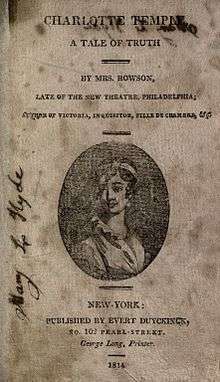Charlotte Temple
Charlotte Temple is a novel by British-American author Susanna Rowson, originally published in England in 1791 under the title Charlotte, A Tale of Truth.[1] It tells the story of a schoolgirl, Charlotte Temple, who is seduced by a British officer and brought to America, where she is abandoned, pregnant, sick and in poverty. The first American edition was published in 1794 and the novel became a bestseller.[2] It has gone through over 200 American editions. Late in life, the author would write a sequel that would be published posthumously.


Plot summary
The book relates the tale of Charlotte Temple, who is enticed by a dashing soldier, John Montraville, to run away with him, but after they cross to America, he abandons her. It belongs to the seduction novel genre popular in early American literature.[3]
The novel opens upon an unexpected encounter between the British Lieutenant Montraville and Charlotte Temple, a tall, elegant girl of 15. Montraville sets his mind on seducing Charlotte and succeeds with the help of his libertine friend Belcour and Mademoiselle La Rue, a teacher at the boarding school Charlotte attends. Mademoiselle La Rue had herself eloped from a convent with a young officer and "possessed too much of the spirit of intrigue to remain long without adventures."[4] Montraville soon loses interest in the young girl and, being led by Belcour to believe in Charlotte's infidelity towards him, trusts Belcour to take care of Charlotte and the child she expects.
Following the advice of her new-found friend and neighbor Mrs. Beauchamp, Charlotte writes home to her mother. Her parents decide to receive her, her father even goes to New York to come get her. Without any financial support - Belcour does not give her the money Montraville put into his hands for her - Charlotte has to leave her house and, having walked to New York on a snowy winter's day, asks the former Mademoiselle La Rue, now Mrs. Crayton, for help. But the now wealthy woman pretends not to even know her for fear of her husband discovering the role she played in the girl's downfall. Charlotte is taken in by Mrs. Crayton's servant and soon gives birth to a child, Lucy. The doctor, however, has little hope of her recovering and asks a benevolent woman, Mrs. Beauchamp, for help. Mrs. Beauchamp is shocked when she recognizes Charlotte Temple in "the poor sufferer".[5] The following day, Charlotte seems "tolerably composed" and Mrs. Beauchamp begins "to hope she might recover, and, spite of her former errors, become an useful and respectable member of society", but the doctor tells her that nature is only "making her last effort"[6] Just as Charlotte is lying on her deathbed, her father arrives and Charlotte asks him to take care of her child.
Upon returning to New York, Montraville goes in search of Belcour and Charlotte. Learning of her death and burial from a passing soldier, Montraville is filled with remorse for his part in her downfall, and angrily seeks out Belcour, killing him in a fight. Montraville suffers from melancholy for the rest of his life. Mr. Temple takes Charlotte's child back to England. The novel ends with the death of Mrs. Crayton (the former La Rue), who is discovered by Mr. Temple in a London doorway, separated from her husband, living in poverty, and repentant for her involvement in Charlotte's downfall. Mr. Temple admits her to a hospital, where she dies, "a striking example that vice, however prosperous in the beginning, in the end leads only to misery and shame."[7]
The author would eventually write a sequel, telling the story of the daughter born to the unfortunate Charlotte, Lucy Temple. Still unpublished at the time of her 1824 death, it would first go to press in 1828 as Charlotte's Daughter, or, The Three Orphans, but later editions would simply bear the daughter's name as title, Lucy Temple.
Sources
Charlotte's seducer and Lucy's father, John Montraville, was apparently based in part on John Montresor, a first-cousin of the author, though there are also reflections of a then-current story about General John Burgoyne.
Notes
- "Charlotte: A Tale of Truth - Brief Background Notes from Lecture on Rowson". Retrieved 2006-12-07.
- It has been called "the biggest bestseller in American History until Harriet Beecher Stowe published Uncle Tom's Cabin in 1852" (Rowson, Susanna. Charlotte Temple and Lucy Temple, Ann Douglas, ed., New York: Penguin Books, 1991, Introduction, pp. vii-viii), and the first American best-selling novel (Watts, Emily Stipes. The Poetry of American Women from 1632 to 1945. Austin, Texas: University of Texas Press, 1978: 56. ISBN 0-292-76435-9 (cloth); ISBN 0-292-76450-2 (paper)).
- Bontatibus, Donna R. The Seduction Novel of the Early Nation: a Call for Socio-Political Reform, East Lansing: Michigan State University Press, 1999.
- Rowson, Susanna. Charlotte Temple, Norton Anthology of American Literature, Ed. Nina Baym, New York, London: Norton, 2002, p. 892.
- Rowson, Susanna. Charlotte Temple, Norton Anthology of American Literature, Ed. Nina Baym, New York, London: Norton, 2002, p. 941.
- Rowson, Susanna. Charlotte Temple, Norton Anthology of American Literature, Ed. Nina Baym, New York, London: Norton, 2002, p. 942.
- Rowson, Susanna. Charlotte Temple. Ed. Cathy N. Davidson. Oxford: Oxford UP, 1986. p. 120.
References
- Rowson, Susanna (1791). Charlotte. A Tale of Truth. Minerva Press, London.
- Rowson, Susanna (1794). Charlotte. A Tale of Truth (1st American ed.). Mathew Carey.
- Rowson, Susanna (1797). Charlotte Temple (3rd American ed.). Mathew Carey.
- Rowson, Susanna (1824). Charlotte Temple. William Ewer, Boston.
External links
| Wikimedia Commons has media related to Charlotte Temple. |
- Charlotte Temple at Project Gutenberg
